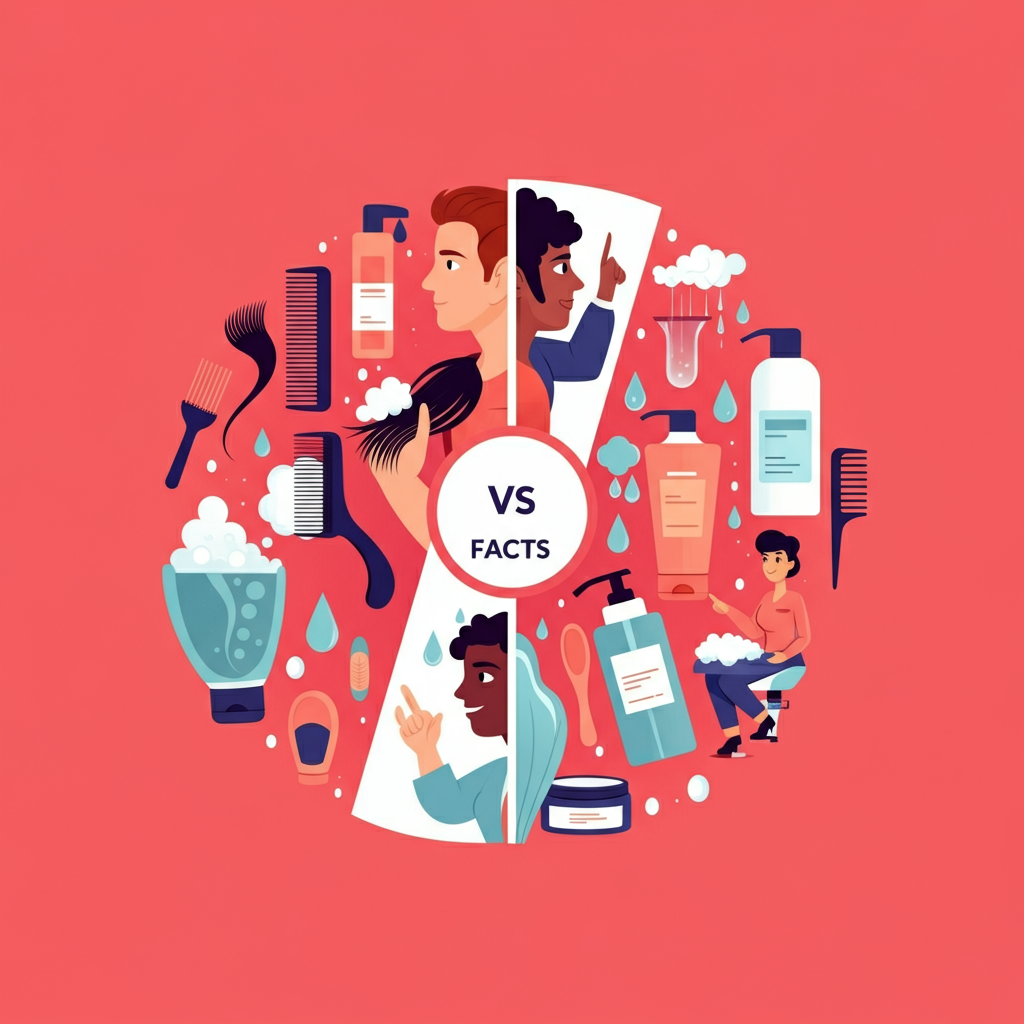
Introduction
Ever heard that trimming your hair makes it grow faster or that brushing it 100 times a day adds a brilliant shine? We’ve all encountered these “golden rules” of hair care, passed down through generations or spread like wildfire on social media. But what if these long-held beliefs are doing more harm than good? It’s time to separate the truth from the trends.
Misinformation about hair care is everywhere. From cultural traditions to viral beauty hacks, it’s easy to get lost in a sea of conflicting advice. The reality is that hair is a complex science, and what works for one person might not work for another. Understanding the scientific hair care principles behind healthy locks is the key to building a routine that delivers real results.
By the end of this guide, you will have a clear understanding of what’s fact and what’s just hype. We will explore the truth about hair care, debunk common hair myths, and empower you with knowledge grounded in science. Get ready to transform your hair care routine by focusing on what truly works.
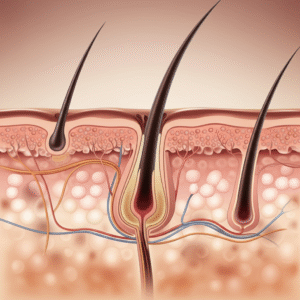
Why Do Hair Myths Persist?
Hair myths often originate from a blend of tradition, anecdotal evidence, and marketing claims. A tip that worked for your grandmother might become family gospel, even if it lacks scientific backing. In the digital age, a single viral video can cement a new myth in the minds of millions overnight, regardless of its accuracy.
Another reason for these common hair misconceptions is the vast diversity of hair itself. Hair type, texture, porosity, and even environmental factors create unique experiences for each individual. A practice that brings life to fine, oily hair might be disastrous for thick, coily hair. This “one-size-fits-all” approach is where many myths are born and why they often fail.
This is why relying on dermatologist-backed information and understanding the science of your own hair is so important. When you learn to distinguish between genuine hair facts you didn’t know and baseless claims, you can make informed decisions that promote long-term hair health.
Hair Growth Myths vs. Facts
The desire for long, luscious hair has fueled countless myths. Let’s look at some of the most persistent hair growth myths and uncover the real science behind how hair grows.
Myth 1: Trimming Your Hair Makes It Grow Faster
❌ The Myth: Many believe that getting regular trims stimulates the scalp and signals the hair to grow at a faster rate.
✅ The Fact: This is perhaps the most famous of all hair care myths. Hair grows from the follicles in your scalp, not from the ends. The average rate of hair growth is about half an inch per month, and cutting the tips has absolutely no biological effect on this process. So, why do stylists recommend regular trims? The answer is health, not speed. Trimming your hair removes split ends—frayed, damaged tips that can travel up the hair shaft, causing further breakage. By cutting them off, you prevent this damage from spreading, which helps your hair retain length and appear thicker and healthier. So, while trimming doesn’t make hair grow faster, it’s essential for helping it grow longer without breaking off.
Myth 2: Oiling Your Scalp Overnight Guarantees Faster Growth
❌ The Myth: Slathering your scalp in oil and leaving it on overnight is the secret to accelerated hair growth. The longer the oil stays on, the better the results.
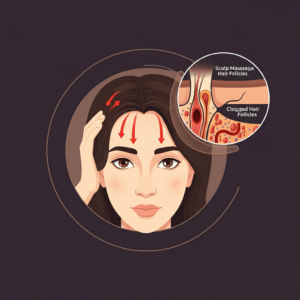
✅ The Fact: While oiling can be beneficial, the magic isn’t in the duration but in the application. The act of massaging the scalp while applying oil stimulates blood circulation, which delivers more oxygen and nutrients to the hair follicles—this is what can support healthy growth. However, leaving excess oil on your scalp for extended periods, especially overnight, can be counterproductive. It can clog pores and hair follicles, potentially leading to scalp issues like dandruff or even inhibiting growth.
For most hair types, a 30-60 minute pre-shampoo oil treatment is more than enough to reap the benefits without the drawbacks. The truth about hair care is that a healthy scalp environment is paramount.
Myth 3: Brushing Your Hair 100 Strokes a Day Makes It Healthy and Shiny
❌ The Myth: This age-old advice suggests that brushing your hair 100 times before bed distributes natural oils, stimulates the scalp, and creates a beautiful, healthy sheen.
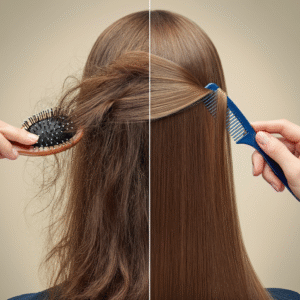
✅ The Fact: This is one of the most damaging hair fall myths. Over-brushing is a direct path to mechanical damage and breakage. While gentle brushing does help detangle and distribute some oils, 100 strokes is excessive and creates unnecessary friction that can weaken the hair cuticle.
This friction can lead to split ends, frizz, and snapping strands. Modern trichologists advise brushing hair only when needed to detangle and style. Use a wide-tooth comb or a gentle brush, start from the ends, and work your way up to the roots to minimize stress on the hair. The shine you’re seeking is better achieved through proper conditioning and a healthy diet.
Myth 4: Hair Growth Products and Serums Work Instantly
❌ The Myth: A new “miracle” oil, serum, or supplement will produce visible hair growth within a few days or weeks.
✅ The Fact: Effective hair growth takes patience and consistency. The hair growth cycle has several phases, and it takes time for any product or treatment to influence it. As mentioned, hair grows at an average rate of about half an inch per month. No topical product can drastically speed up this biological process overnight.
Products designed to support hair growth work by creating an optimal scalp environment, strengthening existing hair, or providing essential nutrients. You’ll typically need to use a product for at least three to six months to see noticeable results, as new, healthier hair needs time to grow long enough to be visible. Believing in instant results is a fast track to disappointment.
Washing and Conditioning Myths vs. Facts
How you wash your hair is the foundation of your entire care routine. Let’s clear up some common myths surrounding shampooing and conditioning.
Myth 5: You Should Wash Your Hair Every Day to Keep It Clean
❌ The Myth: Daily shampooing is necessary for a clean scalp and can lead to healthier hair.
✅ The Fact: This is a classic case of “it depends.” While daily washing can be beneficial for those with very oily scalps or who exercise heavily, it’s not a universal rule. For many people, shampooing daily strips the scalp of its natural oils (sebum), which are essential for keeping hair moisturized. This can trigger the scalp to overproduce oil to compensate, creating a vicious cycle of greasiness. It can also lead to dry, brittle hair. The key is to wash your hair based on your hair type and lifestyle. If your hair isn’t oily or dirty, washing every 2-3 days (or even less for some curly and coily types) is often sufficient. Using a gentle, sulfate-free shampoo tailored to your hair type will also help maintain a healthy balance.
Myth 6: Rinsing with Cold Water Makes Your Hair Shinier
❌ The Myth: A final rinse with icy cold water will “seal” the hair cuticles, locking in moisture and creating a super-shiny finish.
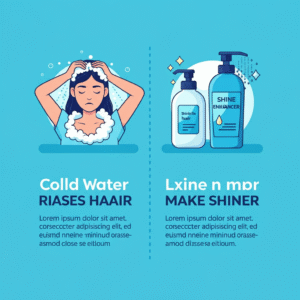
✅ The Fact: While the cold water hair myth is incredibly popular, its effects are temporary and often exaggerated. A blast of cold water can cause the outer layer of the hair, the cuticle, to contract slightly, making it lie a bit flatter. This can give a temporary illusion of smoothness and shine. However, it does not permanently “seal” the cuticle. That job is best done by a well-formulated conditioner, which contains ingredients specifically designed to smooth the cuticle, reduce frizz, and impart lasting shine. A cold rinse isn’t harmful, but it’s not the magic bullet for shine that many believe it to be.
Myth 7: Conditioner Causes Hair Fall
❌ The Myth: Applying conditioner, especially near the roots, weighs hair down and makes it fall out.
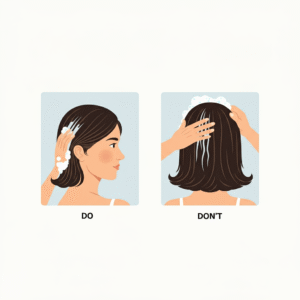
✅ The Fact: This is one of the more misleading hair fall myths. Conditioner does not cause hair to fall out from the root. What you’re likely seeing is hair that has already shed from the follicle and is simply caught in the rest of your hair. Conditioner provides slip, which allows these loose strands to slide out easily during rinsing. Your hair goes through a natural cycle of growth, rest, and shedding. On average, you lose 50-100 hairs per day. Conditioner actually helps prevent breakage by moisturizing and detangling, which reduces the pulling and snapping of healthy hair. The correct way to use it is to focus on the mid-lengths and ends, where hair is the oldest and driest.
Myth 8: You Need to Switch Shampoos Because Your Hair “Gets Used to It”
❌ The Myth: Your hair can build up a tolerance to a shampoo, causing it to stop working effectively over time.
✅ The Fact: Your hair is not a living organism that can adapt or build immunity to products. If your favorite shampoo seems less effective, it’s not because your hair is “used to it.” The likely culprit is product buildup. Styling products, conditioners, and even some shampoos can leave a residue on the hair shaft that weighs it down and makes it look dull. The solution isn’t to constantly switch products, but to incorporate a clarifying shampoo into your routine every few weeks. This will remove the buildup and restore your hair’s responsiveness to your regular products. Changes in your hair’s needs due to weather, hormonal shifts, or chemical treatments can also affect product performance.
Color, Styling, and Treatment Myths vs. Facts
From hair dye to heat tools, styling practices are surrounded by myths. Let’s set the record straight on what’s safe and what’s not.
Myth 9: Dyeing Hair Always Causes Severe Damage
❌ The Myth: Any form of hair coloring, especially bleaching, will inevitably ruin your hair, leaving it dry, brittle, and broken.
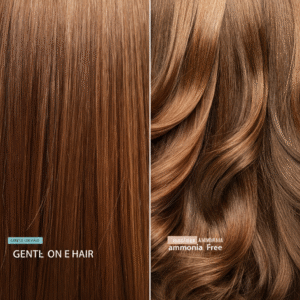
✅ The Fact: While it’s true that chemical processes like dyeing and bleaching can be damaging, it’s not a foregone conclusion that they will destroy your hair. Modern hair color formulas and techniques have come a long way. Many professional and at-home dyes are now formulated with conditioning agents and without harsh chemicals like ammonia.
The extent of the damage depends heavily on several factors: the starting health of your hair, the expertise of your colorist, the process used (going from black to platinum blonde is more stressful than subtle highlights), and your aftercare routine. Using color-safe, sulfate-free shampoos, deep conditioning treatments, and bond-building products can significantly mitigate damage and keep colored hair healthy and vibrant.
Myth 10: Natural Oils Can Be Used as Heat Protectants
❌ The Myth: A little bit of coconut oil or argan oil is all you need to shield your hair from the high temperatures of a flat iron or curling wand.
✅ The Fact: This is a dangerous myth. While natural oils are excellent moisturizers, they are not effective heat protectants. In fact, they can make the problem worse. Oils have a low smoke point, meaning they will essentially “fry” your hair when subjected to high temperatures, leading to severe damage.
True heat protectant sprays and serums are formulated with specific ingredients like silicones (e.g., dimethicone) and polymers (e.g., PVP/DMAPA acrylates copolymer) that create a protective barrier on the hair shaft. This barrier slows down heat conduction and distributes it more evenly, minimizing damage. Always use a product specifically designed for heat protection before styling.
Myth 11: Dandruff Is Caused by a Dry Scalp
❌ The Myth: Those white flakes on your shoulders are a clear sign that your scalp is dry and needs more moisture.
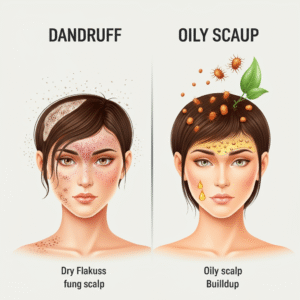
✅ The Fact: This is one of the most common dandruff causes myths. In most cases, dandruff is actually caused by an oily scalp, not a dry one. The primary culprit is a yeast-like fungus called Malassezia globosa, which is a normal inhabitant of the scalp.
This microbe feeds on sebum (scalp oil). When there is an overproduction of oil or an overgrowth of the fungus, it can lead to scalp irritation and an accelerated shedding of skin cells, which clump together to form the visible flakes we call dandruff. Using heavy, oily products to “moisturize” a flaky scalp can actually worsen the problem. The correct approach is to use a medicated anti-dandruff shampoo with ingredients like ketoconazole, selenium sulfide, or zinc pyrithione to control the fungus and oil.
Myth 12: Gray Hair Is Coarser and Grows Faster
❌ The Myth: When hair turns gray, its texture becomes wiry and coarse, and it grows at a faster rate than pigmented hair.
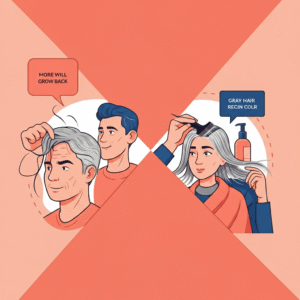
✅ The Fact: Gray hair myths often mix a little truth with a lot of fiction. Let’s break it down. Gray hair lacks melanin, the pigment that gives hair its color. This structural change can affect the hair cuticle, sometimes making it feel a bit drier or finer, not necessarily coarser. The “wiry” feeling is often due to a decrease in sebum production as we age, making the hair less lubricated. As for growth speed, studies show that gray hair does not grow faster than pigmented hair. In fact, as we get older, our hair growth rate naturally slows down, regardless of its color. The reason gray hairs might seem more prominent is simply their contrast against the rest of your hair.
Summary Table: Hair Myths vs. Facts at a Glance
|
Myth |
Fact |
|---|---|
|
Trimming makes hair grow faster. |
Trimming prevents split ends, helping hair retain length as it grows from the root. |
|
Brush hair 100 strokes for shine. |
Over-brushing causes friction and breakage; gentle detangling is all that’s needed. |
|
Cold water rinses “seal” the cuticle. |
The effect is temporary; conditioners are what truly smooth and seal the cuticle. |
|
Conditioner causes hair to fall out. |
Conditioner helps detangle hair, releasing strands that have already naturally shed. |
|
Dandruff means your scalp is dry. |
Dandruff is usually caused by an overgrowth of fungus on an oily scalp. |
|
Your hair “gets used to” shampoo. |
Product buildup is the real issue; use a clarifying shampoo to reset your hair. |
|
Natural oils work as heat protectants. |
Oils can fry your hair; use specially formulated heat protectant products. |
|
Gray hair can be reversed naturally. |
Once melanin-producing cells die, the color cannot be restored naturally. |
How to Verify Hair Care Claims
In a world saturated with information, becoming your own hair care detective is essential. Don’t let clever marketing or viral trends dictate your routine.
- Look for Scientific Sources: Prioritize advice from board-certified dermatologists, trichologists, and cosmetic chemists. These experts understand the biology of hair and the chemistry of products.
- Be Skeptical of “Miracle” Claims: If a product promises instant, dramatic results, be wary. True hair health is a journey, not an overnight fix. Look for realistic claims backed by evidence.
- Understand Your Hair Type: The most important step in scientific hair care is knowing your own hair. Is it fine, medium, or coarse? Straight, wavy, curly, or coily? High or low porosity? Once you understand your hair’s unique properties, you can filter out irrelevant advice and find what truly works for you.
- Patch Test New Products: Before committing to a new product, especially one with active ingredients, do a patch test on a small area of your skin or a hidden section of your hair to check for adverse reactions.
Conclusion: Embrace Science, Not Hype
Navigating the world of hair care doesn’t have to be confusing. By understanding the science behind how hair works, you can confidently bust the myths and build a routine that is based on facts, not fiction. Stop chasing quick fixes and start investing in the long-term health of your hair.
Your hair is unique, and its needs will change over time. Listen to it, learn its language, and provide it with the care it truly deserves. Armed with this knowledge, you are now equipped to make smarter, more effective choices for a lifetime of beautiful, healthy hair.





Leave a Reply